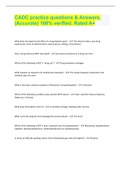Summary
Hull: Options, Futures, and Other Derivatives Summary and Cheat Sheet
- Institution
- London School Of Economics (LSE)
A summary of 'Options, Futures, and Other Derivatives summary' by John C. Hull with focus on the UoL LSE Derivatives and Risk Management syllabus. A handy cheat sheet is included at the end. Save yourself the time of having to sift through the textbook- It is done very concisely here in this do...
[Show more]













